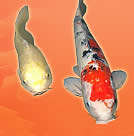More Facts on Koi Fish
Koi fish, or Nishikigoi, are rapidly becoming popular for keeping in garden ponds. Their various colors and patterns can be used to complement the garden theme. Few people know of their characteristics and origins. Become a better owner by learning more about this remarkable fish species.
The first Koi fish were produced by breeding Carp such as the Asian and German Carp. After years of selective breeding, various color mutations started showing up. The first color patterns were recorded as early as 1805. Today, there are literally thousands of color variations available. The most popular colors found are white, silver, yellow, orange, red, black, blue and green.

Combined with the patterns available, the possibilities are almost endless. Each noticeable pattern and color has its own name, which is typically as unique as the color it is referring to. Favorite types vary by country and location.
Koi fish are raised commercially raised in countries like Japan, Singapore, Israel, and in the warmer American states such as Nevada and California. Koi is stocked by most local pet stores. If they are out of stock, fish can normally be ordered. Ordering has its advantages and disadvantages. You have more options when ordering Koi fish, since you do not have to pick from the stock on hand. A disadvantage is that you will not be able to pick specific fish.
Koi, unlike most other fish, will continue to grow until they reach their breeds’ natural size, no matter the environment that they are in. Baby Koi fingerlings can be found as small as 3 inches. Jumbo Koi fish have even been known to reach lengths of three feet or more. The most common size found is between one and two feet in length.
Koi are omnivorous fish, which means they will eat both meat and plants. Their diets are very versatile. Koi fish will eat just about anything that you feed them, no matter if it is healthy for them or not. As their owner you must control their diet. Another potential problem is over feeding treats. Koi fish do not know when to stop eating, and weight issues may arise from overfeeding with none nutritional foods.
The healthiest treats for Koi are found naturally in their ponds, such as earthworms and tadpoles. Koi fish treats could also include Lettuce, bread, fruit, and veggies. You should pay special attention to the certain foods such as corn, beans, and grapes, as they contain an outer casing, which cannot be properly digested. If you wish to feed this to your Koi, be sure to completely remove the outer casings before giving it to your Koi fish.
Koi are none-aggressive fish. This means that they can live with other fish such as goldfish or comets. Koi fish are quick eaters and may deprive smaller fish of food. Koi are so mellow that they have even been known to be trained to eat out of their owner’s hand. Koi fish do not have teeth, so they will not injure you should you attempt to feed them out of your hand.
Koi fish have been known to live up to 30 years under the right conditions. Consider this if you are thinking about buying Koi. The record for the oldest fish is held by a Japanese Koi, which was 233 years old when it died.
Attention: This is limited to the next 7 lucky individuals
“The FREE Shed Plan and Garden Improvement Project ”



